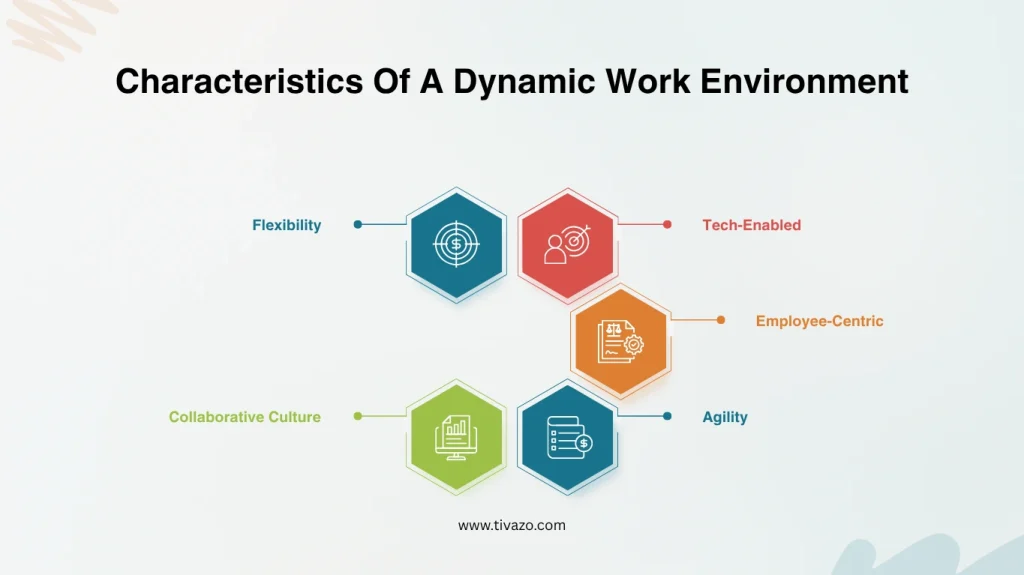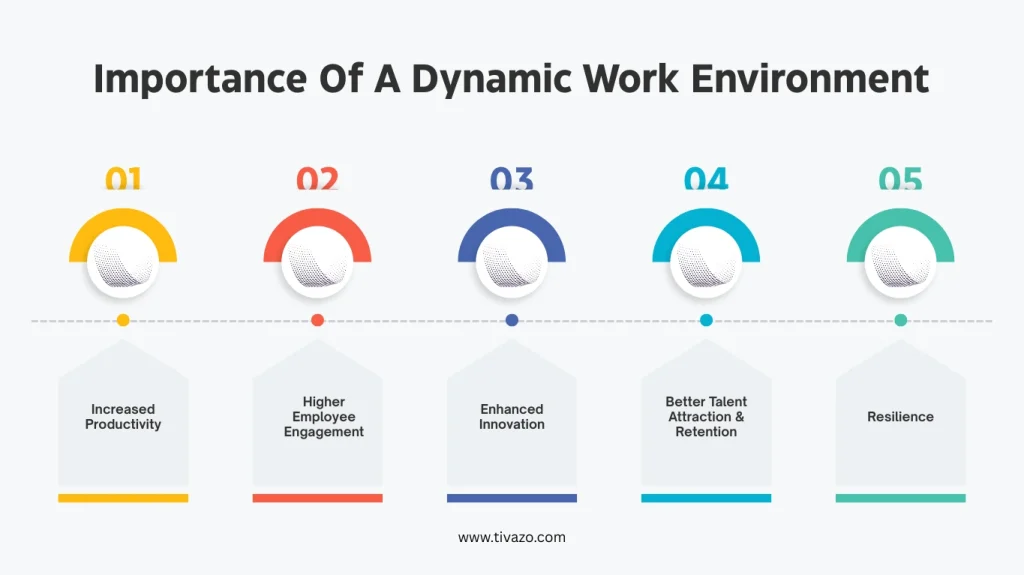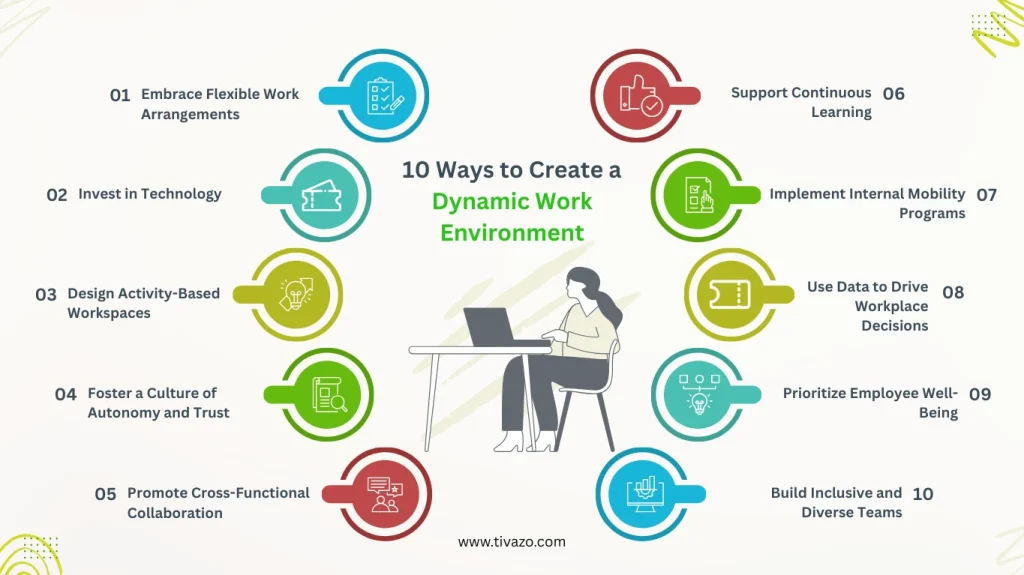In an era where change is the only constant, the ability to quickly pivot is crucial. Enter the dynamic work environment, a transformative approach that drives innovation and employee success.
A Dynamic work environment is characterized by agility, collaboration, and empowerment of employees, where they make use of technology and flexible policies to fulfill an ever-changing need. This is a productivity-enhancing environment as well as a continuous improvement type of environment.
The formation of a strong working environment requires taking on the aspect of workplace innovation by adopting flexible procedures and all-inclusive communication. Organizations can develop a future-oriented, prosperous work environment by paying attention to employee engagement, cross-functional cooperation, and reskilling. This article will be devoted to the definition of a dynamic work environment, its essence, and how to create an environment that satisfies the needs of contemporary business and employees.
🔑Key Highlights:
- Characteristics of a dynamic work environment
- Importance of a Dynamic Work Environment
- 10 Ways to Create a Dynamic Work Environment
What is a Dynamic Work Environment
A dynamic work environment is a flexible, adaptable, and technology-driven workplace designed to respond quickly to change, whether it be in market demands, employee needs, or global circumstances. Unlike static workplaces with rigid schedules and fixed seating, dynamic environments promote fluidity in work arrangements, encourage collaboration across functions, and empower employees with autonomy.
According to Deskbird, a dynamic work environment is characterized by autonomy, internal mobility, cross-functional collaboration, and a culture of continuous improvement. It leverages digital tools to facilitate communication and remote work, ensuring teams remain efficient regardless of their location.
What are the characteristics of a dynamic environment?
It is worth knowing that knowing the primary characteristics of the dynamic work environment is one of the requirements that any modern organization needs to remain competitive in the modern, swift workplace. Such characteristics not only encourage adaptability in the workplace but also encourage a culture of innovation and engagement among the employees that ensures the long-term success of a company.

1. Flexibility
The dynamic work environment is founded on flexibility, which enables employees to change their workplace, job positions, and work hours depending on the changing business demands. This flexibility supports teams to remain fruitful and versatile, whether they work remotely, in hybrid environments, or on-site.
2. Tech-Enabled
The dynamic work environment also depends on technology such as real-time data, scheduling software, and collaboration tools to simplify the working process. Such electronic tools help exchange and coordinate information effortlessly with remote and hybrid teams.
3. Employee-Centric
Making employees central to the working environment implies focusing on their health, interactions, and development. When a company has a dynamic work environment, people get support and feel honored to give their best in their work.
4. Agility
Agility in a dynamic work environment requires flexibility to change direction due to internal change or external market changes. This agility makes it possible to avoid any uncertainties so that the organizations manage to outsmart their rivals by adjusting their strategies and processes all the time.
You May Also Like: 5 Levels of Agile Planning: Master Every Stage Fast
5. Collaborative Culture
It is also important and critical to a dynamic work environment to encourage co-working across various teams and departments. Collaboration between workers across the functions leads to innovation, better problem identification and resolution, and a workforce that is more united and built on a solid foundation.
More importantly, once the characteristics are embraced, it is possible to turn any conventional working space into a real, dynamic work environment, resulting in employee happiness and business maneuverability. With the ability to concentrate on flexibility, technology, staff-centered policies, agility, and cooperation, corporations can develop a robust and future-friendly working environment.
Why is a Dynamic Work Environment Important?
The conventional office set up of 9-to-5 is not adequate in the digital era. Companies need to innovate continuously, be fast enough to react to the changes in the market, and find the best talent to hire and keep them engaged and productive. The following are the significance of a dynamic work environment.

1. Increased Productivity
The enterprises benefiting from the implementation of the dynamic work environment witness a significant rise in the productivity of employees. According to the Gloat, companies that adopt internal mobility and agility are 20 times more probable to attain high-performed productivity in light of the fact that the empowered employees operate in flexible and accommodating environments.
2. Higher Employee Engagement
A flexible and dynamic work environment generates a sense of psychological safety and raises employee involvement. Employees who feel special and trusted tend to remain at the job all the more, thereby producing a high level of commitment and motivation in workers.
3. Enhanced Innovation
The dynamic nature of workplaces stimulates cross-functional collaboration, resulting in innovative solutions to problems and faster decision-making. This challenge can be eliminated by clearing silo mentality and embracing divergent thinking, which renders innovative concepts that place companies above their competitors in a competitive world.
4. Better Talent Attraction & Retention
The world is a talent-driven market, and people working in the market want flexible workplaces that offer chances to grow. These expectations cannot be overlooked because a dynamic work environment allows organizations to recruit the most successful talents and limit expensive turnover.
5. Resilience
Dynamic work environment Agility is one of the most essential aspects of a dynamic work environment, which enables businesses to redirect talent and re-strategize immediately when disruptions occur. Such strength helps to secure the continuity of business regardless of unforeseen circumstances.
These significances support the reason why most of the top firms are shifting to more dynamic working patterns.
You May Also Like: 4 Best Benefits of a Rotating Shift Schedule In 2025
How to Create a Dynamic Work Environment: 10 Proven Ways
Transforming your workplace into a dynamic environment is a strategic process that involves culture shifts, technology investments, and thoughtful design. Here are ten effective steps to guide you:

1. Embrace Flexible Work Arrangements
A dynamic working environment is all about flexibility. Allowing workers to have a choice over where and how they work, whether at home or in the office, or as a hybrid model. allows workers to juggle their personal and professional needs. As a result of this freedom, there is greater satisfaction at work, less burnout.
Clickstop also states that places of work with more flexible working hours work better in terms of employee involvement and well-being. Flexibility gives teams the opportunity to work around in their own ways, which in our current work environment, which is fast-paced and ever-changing, is of utmost importance.
When you incorporate the essence of flexibility into your organization, workers will feel appreciated and trusted. Trust promotes independence and motivates improved performance, and therefore, flexibility leads to a win-win situation between the employers and the employees.
2. Invest in Technology That Enables Collaboration
Smooth communication, in particular, within remote and hybrid teams, is the backbone of a dynamic work environment. When an organization promotes an interconnected working environment by investing in tools such as Slack, Microsoft Teams, and other project management software, the flow of information becomes smooth.
Deskbird also emphasizes that the use of space is optimized since offices are made more efficient and comfortable with the help of real-time scheduling and desk-booking applications. Such technologies avoid friction when organizing a meeting or when finding spaces, allowing employees to concentrate on work.
Technology is not only a way to expedite work processes; it creates a culture of teamwork and flexibility. Innovation and teamwork come instinctively when employees are able to communicate and share ideas with ease.
3. Design Activity-Based Workspaces
The physical arrangement of a workplace is also important to productivity and the satisfaction of employees. Within a dynamic work environment, the space will facilitate different activities: a focus space, a teamwork room, and informal communal areas of relaxation.
Clickstop attaches importance to ergonomic furniture, a lot of natural light, and a modular, adjustable design. These architectural features alleviate fatigue and assist in the change between various activities during the day.
This type of activity-based work environment motivates workers to fulfill their tasks at the place where they feel most productive, making them feel comfortable and stimulating their creativity, diverse working habits, and needs.
4. Foster a Culture of Autonomy and Trust
Loyalty is one of the pillars in a dynamic work environment. Empowering employees to make decisions and control their work motivates them and makes them feel like the owners. The independence helps in spurring creativity and brings less stress.
The Forbes coaches suggest that psychological safety should be created by nurturing open communication and explicit expectations. Employees who feel secure in communicating ideas and are risk takers are more interested and more productive.
A trust-based culture promotes a culture of collaboration and responsibility. The thing is that once the teams are assured of the support of the management, it is more willing to raise their game and provide the best performance.
5. Promote Cross-Functional Collaboration
Dynamic work environment eliminate traditional silos as it ensures that workers in various departments work together on projects. This cross-disciplinary collaboration will be able to create innovation, as a result of multi-dimensional thinking.
Teamwork also improves problem-solving, and the employees develop a wider knowledge of what the organization is about. It follows a revolutionary pace of making decisions and responding to changes.
The promotion of cross-functional cooperation results in a workplace culture of never-ending discovery and advancement, and a sense of identification with the mission of the company by all team members.
6. Support Continuous Learning and Upskilling
The ever-changing workplace requires lifelong learning. A dynamic work environment uses learning moments as part of everyday practices, including mentorships, project rotations, and skills training opportunities.
Such platforms as Gloat emphasize the significance of skills-focused strategy, which allows employees to remain relevant and confident in their positions. Besides the benefits to an individual, upskilling increases organizational agility.
As organizations focus on learning and development, they ensure that they develop a workforce that is flexible, creative, and up to addressing any emerging challenges.
7. Implement Internal Mobility Programs
Internal mobility is a chance to find new jobs and projects in the company, depending on the abilities and interests of the employees. This mobility maintains the engagement through providing career opportunities even when one is still within the organization.
In the study conducted by Gloat, strong internal mobility programs and vigorous competitiveness of an organization surpass competitors in retention and agility. Talent could be reallocated within no time when business needs shift, and thus the momentum could be kept during the time of change.
When organizations promote internal mobility, they end up having a complex ecosystem in which employees keep changing and generating new, valuable contributions.
8. Use Data to Drive Workplace Decisions
In a dynamic work environment, data-driven decision-making is fundamental. Collaboration analytics, occupancy sensors, and employee feedback offer valuable insights to drive more value out of every pound of space, workflow, and time.
Real-time data allows organizations to change fast, either in terms of rearranging desks, changing team structures, or removing bottlenecks. These insights are used to introduce continuous improvement that makes workplaces efficient and friendlier to their employees.
Using data will establish the culture of responsiveness and innovativeness where leaders are able to build environments that, in reality, facilitate productivity and engagement.
9. Prioritize Employee Well-Being
The well-being of employees plays a key role in maintaining a dynamic work environment. By providing wellness programs, mental health instruments, and reminders to take breaks, it is possible to avoid burnout and ensure high performance.
Forbes asserts this much by noting that one should experience intensive work time and downtime in periods to sustain long-term productivity. Employee well-being programs make them feel appreciated other than their performance.
Health and wellness priority will establish a good workplace culture where employees feel valued, thus improving morale and loyalty.
10. Build Inclusive and Diverse Teams
Creativity and innovation at dynamic workplaces thrive based on diversity and inclusion. When we appreciate the value of various backgrounds and views, we get more ideas and effective solutions to problems.
Decision-making and communication that have inclusive approaches create the much-needed feeling of belonging and psychological safety, and this, in turn, contributes to higher worker engagement and satisfaction.
Through developing teams of different kinds, organizations are able to produce spaces within the work environment that are not only dynamic but also fair and strong enough to weather any change.
Conclusion
A dynamic work environment is no longer optional for companies aiming to remain competitive and innovative. It fosters flexibility, collaboration, and employee well-being, fueling productivity and long-term success.
By implementing flexible policies, leveraging technology, designing adaptive spaces, and cultivating an empowering culture, organizations can create workplaces that not only respond to change but thrive on it.
Remember, the journey toward a dynamic work environment is continuous—embrace data, listen to your people, and iterate relentlessly.
FAQ’s
What is a dynamic office environment?
A dynamic office environment is a workspace designed for flexibility, collaboration, and productivity. It often includes activity-based work areas, digital tools, and policies that support remote and hybrid teams.
How to create a dynamic environment?
To create a dynamic environment, embrace flexible work arrangements, invest in collaboration technology, foster a culture of trust, encourage continuous learning, and support employee well-being.
How to be a dynamic employee?
A dynamic employee is adaptable, proactive, and collaborative. They embrace change, seek growth opportunities, solve problems creatively, and contribute positively to team and organizational goals.




